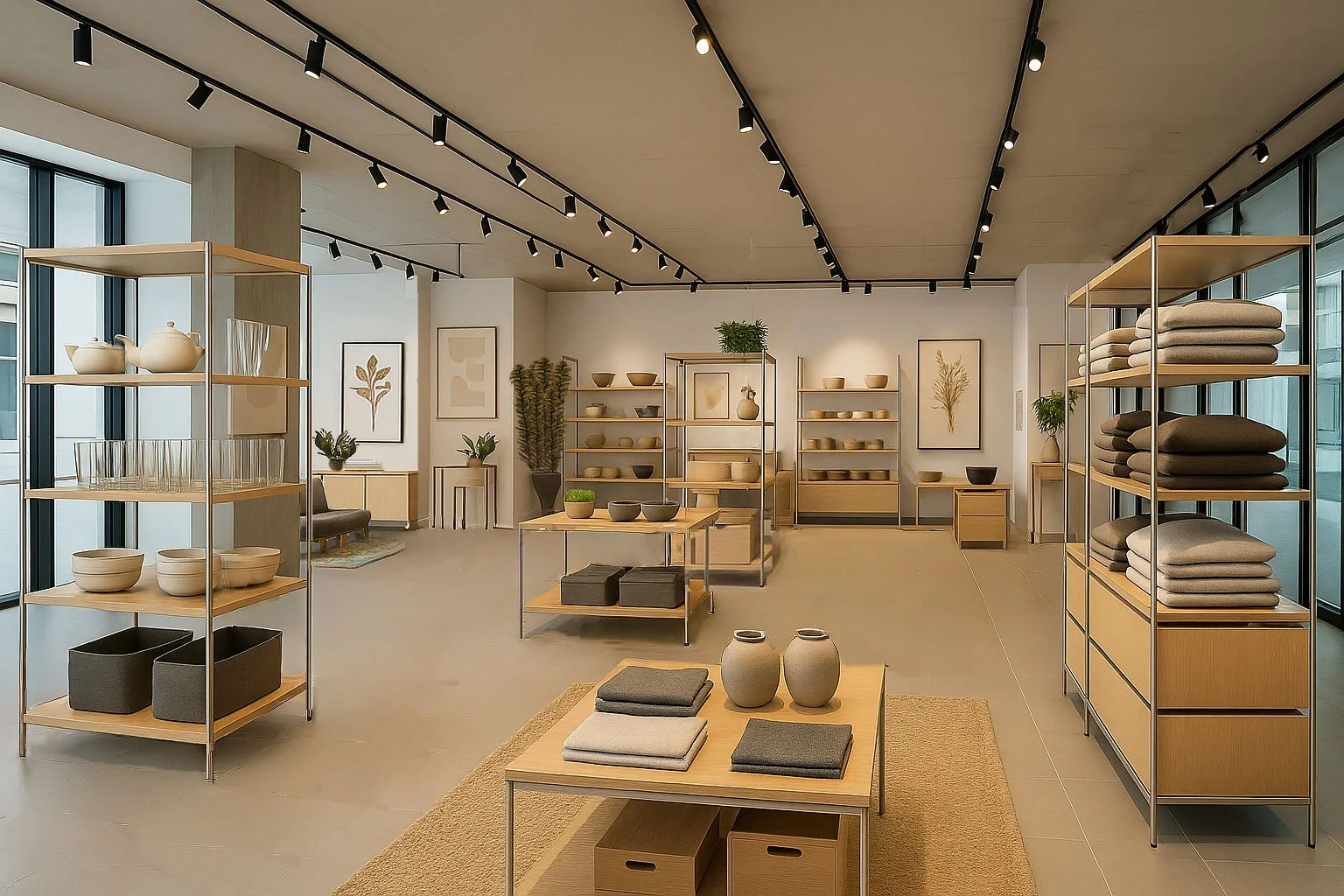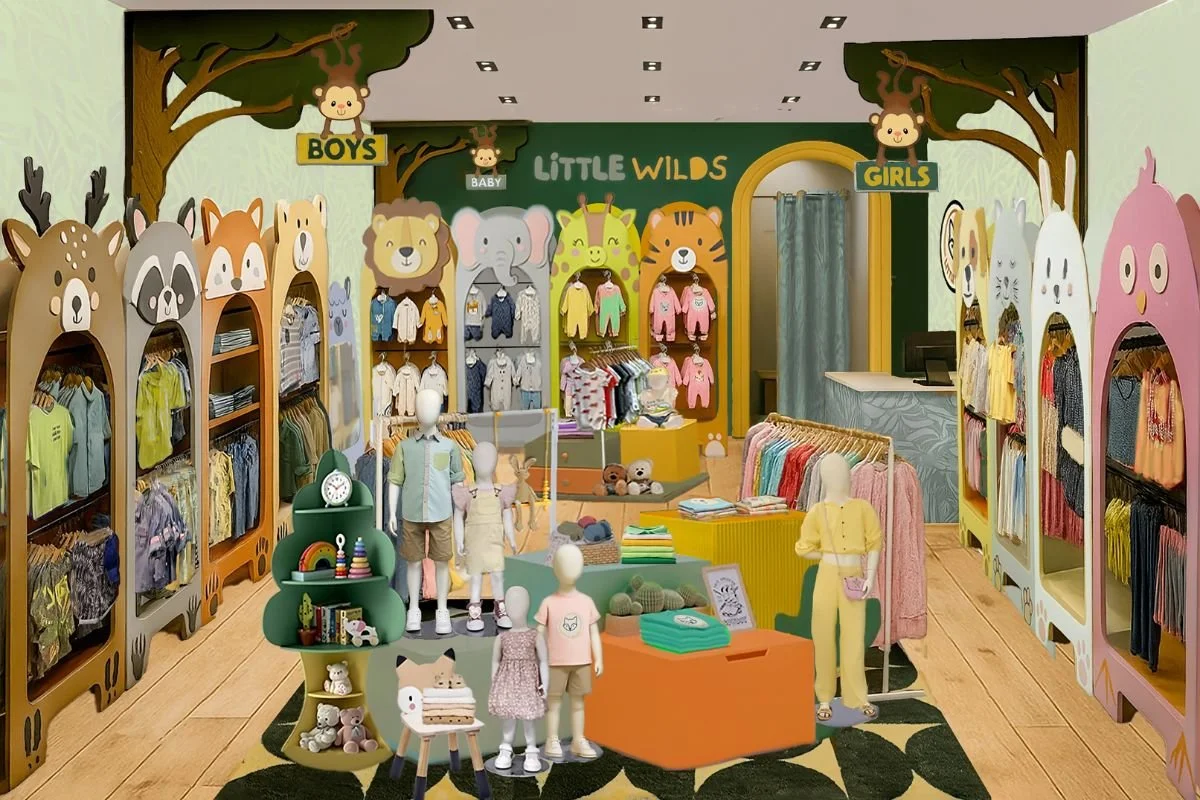Visual Merchandising Trends for 2026: How Brands Are Blending Storytelling, Tech, and Sustainability
1. Sustainability Is the New Standard
Sustainability has stopped being a selling point — it’s now the baseline. In 2026, brands are re-thinking not just what their fixtures look like but how they’re made, shipped, and reused.
Recycled timber, reclaimed metal, and low-VOC paints are replacing synthetic finishes.
Local manufacturing reduces shipping miles and lead times.
Fixtures are designed to disassemble, store, and re-skin between campaigns.
Sustainable retail fixture made from recycled timber panels image soucre
In action:
Lush stores have become a global benchmark for ethical, sustainable visual merchandising. Almost every element in their environment tells that story — from reclaimed timber crates and repurposed barrels to hand-painted signage made from recycled paperboard. Even the concrete floors are chosen for their longevity and low-waste installation.
Instead of hiding their environmental values, Lush makes them part of the aesthetic. The space feels alive: natural textures, bright colours, and an unmistakable scent combine to draw people in and reinforce the brand’s “fresh, handmade” message.
The store also showcases a key 2026 mindset — eco-authenticity through transparency. Customers instantly see that the brand’s sustainability commitment isn’t a corporate claim; it’s built into the physical store itself.
Why it works:
Every display fixture doubles as proof of the brand’s sustainability ethos.
The layout invites touch and exploration, turning ethical retail into a multisensory experience.
The materials are modular and easy to refresh without costly rebuilds.
Try this:
Think of every display as part of a longer story. Instead of building something that only lasts one season, design it to evolve. For instance, a timber podium could be resurfaced with new laminate each year, while the frame remains the same. Add small “eco tags” or QR codes explaining the sustainable materials — shoppers love seeing authenticity displayed, not just claimed.
2. The Digital-Physical Blend
Technology has woven itself into every layer of retail. The most successful brands now blend physical touchpoints with digital storytelling.
Customer using Sephora’s AI-powered Virtual Artist mirror to virtually try on lipstick shades inside a sleek, well-lit beauty retail environment. image source
In action:
Sephora has mastered the art of turning technology into an enhancer, not a distraction. Their in-store AI-powered “Virtual Artist” mirror allows customers to try on hundreds of lipstick shades and eye colours instantly—no swatching, no makeup remover, no waiting. The digital mirror overlays shades in real time using facial-mapping technology, while the surrounding product display remains beautifully tactile and accessible.
What makes this work is the seamless integration between the digital tool and the physical environment. The mirrors are surrounded by clean lighting, tester displays, and clear signage that guides shoppers to the exact shades they’ve just tried virtually. Customers can even scan their results to save favourite looks to their profile or order online later.
It’s not tech for tech’s sake; it’s tech that empowers. By removing friction and uncertainty, Sephora has made experimentation easy—and that sense of play keeps people lingering longer and spending more.
Why it works:
Blends digital convenience with physical immediacy.
Encourages trial and discovery without the hygiene or time barriers of real samples.
Creates data-driven insights for Sephora to refine layout, lighting, and product placement.
Try this:
Add a digital moment that genuinely helps your customer, not distracts them. It might be a touchscreen mirror that recommends accessories based on what’s tried on, or a motion-triggered screen showing “how it’s made” content. Even a simple QR code leading to behind-the-scenes videos can transform a static display into an interactive experience.
The goal: make tech feel seamless, not showy.
3. Personalisation & Agility in Store Design
Retailers want to move fast without rebuilding their stores every quarter. The key is modular design that adapts to season, audience, or location.
Modular shelving and display tables allow endless flexibility — reconfigure, restyle, or refresh without rebuilding.
In action:
This space is a perfect example of how modular design keeps stores agile and timeless. Every fixture here — from the open shelving systems to the display tables and drawer units — has been built with adaptability in mind. The neutral colour palette and lightweight materials make it easy to restyle the space for different seasons or product categories without a full rebuild.
Each unit is independent yet cohesive, designed to move, stack, or rearrange as needed. The mix of open shelving and enclosed drawers gives visual rhythm and functionality — storage below, storytelling above. It’s retail architecture that works with the merchandiser, not against them.
This modularity also empowers teams to tailor layouts to local markets or special collections. Whether it’s a pop-up capsule display, a seasonal refresh, or a product launch, the same core fixtures flex to create an entirely new atmosphere — cutting down on both waste and cost.
Why it works:
Fixtures can be reconfigured or re-skinned without specialist installers.
The design language remains consistent even as the layout changes.
Modular elements simplify logistics, improve sustainability, and reduce visual fatigue for returning customers.
4. The Rise of Immersive, Sensory Environments
Lighting and sound now play as much of a role as product. Brands are investing in experience moments—where emotion, not shelving, sells.
Coach’s “Windows of the Future” brings storytelling to life — part theatre, part technology, all brand experience.
In action:
Coach’s “Windows of the Future” campaign transformed the brand’s traditional façade into a theatrical experience. The centrepiece: Rexy the dinosaur, bursting through a digital skyline of New York rendered on an LED wall. Sound, light, and motion worked together to pull passers-by into a story that blended nostalgia and innovation.
The design wasn’t about showcasing a single product — it was about building a moment worth remembering. The oversized animated installation created social-media buzz and attracted foot traffic long after the initial reveal. It’s a perfect example of how immersive storytelling can make a brand feel alive, even from outside the store.
Why it works:
Uses large-scale motion and light to command attention.
Turns a static window into a shareable, cinematic moment.
Aligns perfectly with Coach’s playful brand DNA while elevating luxury presentation.
5. Store as Media Channel
Every surface can now tell a story. Walls, mirrors, and even shelves double as branded media spaces powered by data.
Strand’s Bondi Junction flagship turns digital storytelling into atmosphere — where campaigns, lighting, and layout work in perfect harmony. image source
In action:
Stella McCartney’s flagship stores were among the first luxury brands to replace traditional printed posters with looping digital video walls. Instead of showcasing static product imagery, each mosaic screen plays snippets of short films — exploring themes like sustainability, craftsmanship, and season-specific narratives.
The result is a storefront that behaves more like a media channel than a display. Motion, rhythm, and sound draw attention from passers-by while giving returning shoppers fresh visual content each week. The mannequins stay minimal and still, acting as quiet anchors while the digital storytelling shifts and evolves behind them.
This approach transforms a window into an active piece of brand communication — one that’s flexible, future-ready, and always in motion.
Why it works:
Brings storytelling and campaign imagery to life without additional print waste.
Keeps visual content dynamic and easily updated across global stores.
Reinforces the brand’s innovative, sustainable, and fashion-forward identity.
6. Experience & Emotion
People crave connection more than perfection. The best stores make shoppers feel something, not just see something.
An imaginative kidswear concept that balances playfulness with smart retail zoning — every fixture tells part of the story.
In action:
The Little Wilds concept store shows how immersive design can transform kidswear retail into a world of imagination and exploration. Each wall fixture becomes part of the story — animal silhouettes, forest cutouts, and playful shapes frame the clothing displays, making the shopping journey feel like a walk through the woods.
Instead of relying on gimmicks, the layout encourages interactive discovery. Boys, Girls, and Baby zones are clearly defined, yet visually connected through consistent materials, colour blocking, and those adorable animal arches. The central tables and shelving allow parents and children to explore side by side — tactile, approachable, and fun.
This kind of storytelling doesn’t just appeal to kids — it connects emotionally with parents too. By balancing visual theatre with functional retail, Little Wilds creates a space that’s memorable, navigable, and built for both play and purchase.
Why it works:
Immersive theme instantly sparks curiosity and engagement.
Defined zones improve navigation without breaking design unity.
Emotional storytelling builds brand loyalty and family connection.
7. The Gen Z Store: Shareable, Ethical, Digital
Gen Z shoppers see retail as entertainment. They expect stores to feel authentic, inclusive, and share-worthy.
Playful, photogenic design turns customers into storytellers — every corner made to be shared.
In action:
The Museum of Ice Cream pioneered a new type of retail — one that’s built as much for the camera as it is for the customer. Every corner of this space is designed for interaction, discovery, and content creation. The pastel pinks, soft mints, and pops of yellow create instant visual delight, while playful zones like sprinkle pools and tasting stations turn shopping into a full-sensory, story-driven experience.
For Gen Z, retail is entertainment — a place to connect, create, and share. The Museum of Ice Cream taps into that desire by making every display Instagram-ready. Visitors don’t just shop; they participate in the brand’s world, becoming part of its marketing narrative with every photo they post.
Why it works:
Encourages organic social media engagement through design and colour psychology.
Blends physical fun with digital virality — every visitor becomes a brand advocate.
Uses playful design to create emotional connection rather than transactional retail.
8. Minimalism & Storytelling Combined
In an overstimulated world, quiet confidence sells. Minimalist layouts help customers focus on quality over quantity.
Allbirds uses quiet design and natural materials to tell a powerful sustainability story — proof that minimalism speaks volumes.
In action:
Allbirds’ flagship stores prove that minimalism doesn’t mean emptiness — it means clarity. Each display tells the brand’s sustainability story through form, texture, and restraint. Shoes are showcased individually on soft-toned wall panels, letting materials and colourways speak without distraction.
The environment uses natural materials like timber, wool, and recycled composites, reinforcing the company’s eco-conscious narrative. Instead of cluttered signage, small embossed words — “Tree,” “Wool,” “SweetFoam” — quietly tell the story of each product’s origin. It’s a tactile form of storytelling that invites customers to explore at their own pace.
The result is a retail space that feels calm, confident, and purposeful — a physical manifestation of the brand’s mission to tread lighter on the planet.
Why it works:
Minimal design lets the sustainability message shine without preaching.
Every material choice supports the brand’s eco ethos.
Storytelling is built into the fixtures and finishes, not just the marketing copy.
Wrapping Up
Visual merchandising in 2026 is all about connection and evolution.
Design responsibly.
Integrate technology naturally.
Tell stories that move people.
The best displays don’t shout — they speak clearly, adapting to new seasons, values, and ways of shopping.
💡 Want to future-proof your brand’s in-store experience?
Troy Ware Creative helps retailers design flexible, story-driven spaces that engage customers and strengthen brand identity.








